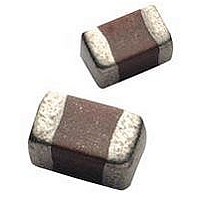12065E104ZAT2A AVX Corporation, 12065E104ZAT2A Datasheet - Page 43

12065E104ZAT2A
Manufacturer Part Number
12065E104ZAT2A
Description
Cap Ceramic 0.1uF 50VDC Z5U -20% to 80% SMD 1206 Paper T/R
Manufacturer
AVX Corporation
Type
Flatr
Series
1206r
Specifications of 12065E104ZAT2A
Package/case
1206
Mounting
Surface Mount
Capacitance Value
0.1 uF
Dielectric
Z5U
Voltage
50 Vdc
Product Length
3.2 mm
Product Height
1.5(Max) mm
Product Depth
1.6 mm
Tolerance
-20 to 80 %
Dielectric Characteristic
Z5U
Capacitance
0.1µF
Capacitance Tolerance
+80, -20%
Voltage Rating
50VDC
Capacitor Case Style
1206
No. Of Pins
2
Capacitor Mounting
SMD
Rohs Compliant
Yes
Case Code
1206
Case Size
1206
Material, Element
Ceramic
Termination
SMT
Operating Temperature Range
+ 10 C to + 85 C
Temperature Coefficient / Code
Z5U
Package / Case
1206 (3216 metric)
Product
General Type MLCCs
Dimensions
1.6 mm (0.063 in) W x 3.2 mm (0.126 in) L
Dissipation Factor Df
4
Termination Style
SMD/SMT
Lead Free Status / Rohs Status
RoHS Compliant part
42
General Description
Energy Stored – The energy which can be stored in a
capacitor is given by the formula:
Potential Change – A capacitor is a reactive component
which reacts against a change in potential across it. This is
shown by the equation for the linear charge of a capacitor:
where
Thus an infinite current would be required to instantly
change the potential across a capacitor. The amount of
current a capacitor can “sink” is determined by the above
equation.
Equivalent Circuit – A capacitor, as a practical device,
exhibits not only capacitance but also resistance and induc-
tance. A simplified schematic for the equivalent circuit is:
Reactance – Since the insulation resistance (R
very high, the total impedance of a capacitor is:
where
The variation of a capacitor’s impedance with frequency
determines its effectiveness in many applications.
Phase Angle – Power Factor and Dissipation Factor are
often confused since they are both measures of the loss in a
capacitor under AC application and are often almost identi-
cal in value. In a “perfect” capacitor the current in the
capacitor will lead the voltage by 90°.
R
C = Capacitance
s
dV/dt = Slope of voltage transition across capacitor
= Series Resistance
X
R
X
Z = Total Impedance
C
L
s
Z =
C = Capacitance
L
E = energy in joules (watts-sec)
V = applied voltage
C = capacitance in farads
I = Current
= Series Resistance
= Capacitive Reactance =
= Inductive Reactance
R
2
S
+ (X
I
C
ideal
- X
R
= C dV
E =
L
S
)
2
dt
1
⁄
2
CV
R
L = Inductance
p
2
= Parallel Resistance
= 2 π fL
2 π fC
1
R
C
P
p
) is normally
In practice the current leads the voltage by some other
phase angle due to the series resistance R
ment of this angle is called the loss angle and:
for small values of
which has led to the common interchangeability of the two
terms in the industry.
Equivalent Series Resistance – The term E.S.R. or
Equivalent Series Resistance combines all losses both
series and parallel in a capacitor at a given frequency so
that the equivalent circuit is reduced to a simple R-C series
connection.
Dissipation Factor – The DF/PF of a capacitor tells what
percent of the apparent power input will turn to heat in the
capacitor.
The watts loss are:
Very low values of dissipation factor are expressed as their
reciprocal for convenience. These are called the “Q” or
Quality factor of capacitors.
Parasitic Inductance – The parasitic inductance of capac-
itors is becoming more and more important in the decou-
pling of today’s high speed digital systems. The relationship
between the inductance and the ripple voltage induced on
the DC voltage line can be seen from the simple inductance
equation:
Dissipation Factor = E.S.R. = (2 π fC) (E.S.R.)
Watts loss = (2 π fCV
Loss
Angle
Power Factor (P.F.) = Cos
Dissipation Factor (D.F.) = tan
V = L di
I (Ideal)
dt
E.S.R.
IR
I (Actual)
the tan and sine are essentially equal
f
s
2
) (D.F.)
X
C
Phase
Angle
f
or Sine
C
S
. The comple-
V










